#acrochordus
Explore tagged Tumblr posts
Text

Elephant Trunk Snake aka Javan File Snake (Acrochordus javanicus), family Acrochordidae, Malaysia
photograph by Bryce Trevett
#elephant trunk snake#file snake#acrochordus#acrochordidae#snake#reptile#herpetology#animals#nature#asia
25K notes
·
View notes
Photo

Omg 🥺
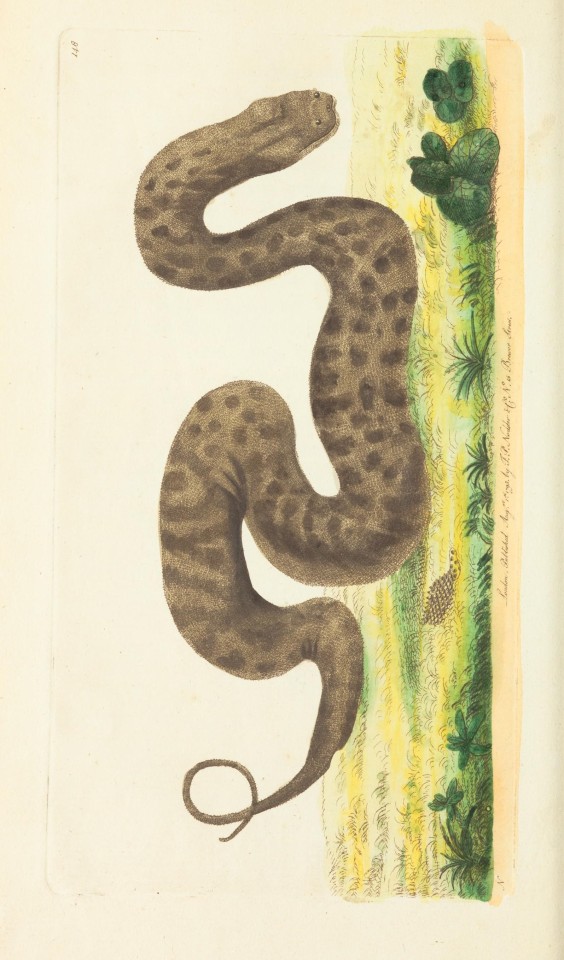
🐘 The naturalist’s miscellany, or Coloured figures of natural objects. London: Printed for Nodder & Co., 1789-1813.
287 notes
·
View notes
Text
Kaiju OC - Acrochordus
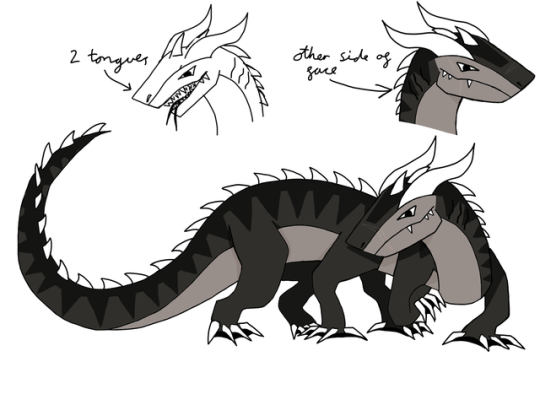
Meet my Kaiju OC, Acrochordus, the big snek with legs.
Acrochordus is a semi-aquatic kaiju currently residing in Sri Lanka, at Outpost 63. Despite his grumpy appearance, he’s usually quite calm and laid-back, though he can be brutal on the battlefield. He spends most of his time in the water, and swims by propelling his body through undulating his tail like a crocodile. He is capable of causing tsunamis and earthquakes with his massive tail, and had an extremely powerful bite force, strong enough to completely chomp through one of Ghidorah’s necks
He stand at around 285 feet when on all 6 legs, and around 425 feet when on his hind legs. His total length is roughly 1,194 feet (tail to head) and his swimming speed can go up to 80m per hour/around 70 knots.
Acrochordus is an ambush predator, lurking in dark water or half-buried in sand or dirt, before pouncing on any kaiju unfortunate enough to not notice him, coiling around them until they stop moving.
He’s also directly responsible for most giant snakes and dragons in myths and legends. Sea-faring vikings called him Jormungandr, the World Serpent, after catching sight of him swimming, with them being unable to see his legs. He also greatly contributed to asian dragons by being spotted on multiple occasions around China and Japan.
I got his name from an actual genus of aquatic snakes that are found in Australia and tropical Asia, his colours and patterns are directly inspired from the pictures I found online.
5 notes
·
View notes
Text
daily snake #1
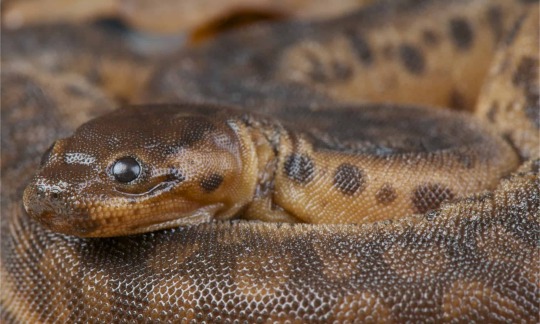
🤎 The Arafura file snake (Acrochordus arafurae), first described in 1979, is an aquatic snake species native to northern Australia and New Guinea. They can grow to 8.25 ft in length, and can give birth to up to 17 little ones!
2 notes
·
View notes
Text
One of my favorite introductions to terrarium pets, is the Digest for the Successful Terrarium from 1989, penned by Richard D. Bartlett for the Tetra Press imprint. Bartlett is a prolific author in the field of exotic animal care in the home, and Tetra Press is, of course, the print media imprint of the aquarium products manufacturer, Tetra. Who pimp their own produce throughout, what is in my humble opinion, one of the better introductions to reptile and amphibian care for lay amateurs.
Since I have started this aquarium related blog, I have pondered creating content about terrarium pets as well. I have certainly cared for all the traditional 'orders' of reptiles except the tuataras, and all three 'orders' of amphibians, as well as tarantulas, scorpions, land crabs and other arthropods. But I stick so far to coverage of aquatic and amphibious fauna, as related to the terrarium. Small though it is, the Digest feels most focused on aquatic and amphibious 'herps' - interestingly, no arthropods are featured - with the desert reptiles occupying only a minority of the pages.

People forget often that the commonly used word 'aquarium', actually started as short for an 'aquatic terrarium' - though arguably this is a inaccurate etymology, when aquaria have no terrestrial area. In any case the word has been with us since the Victorians, who made aquarium ownership fashionable.
Between the terrarium and the aquarium, exists the paludarium, riparium, or aquaterrarium. Or as Bartlett labels them, the semi-aquatic terrarium. Very often people without experience or naturalists knowledge, feel inspired to start a paludarium system, especially one with a waterfall and maybe a fog machine. Unfortunately these plans usually fail for elementary reasons.
Bartlett also discusses the 'turtle aquarium' by which he means a standard aquarium with a low water level, and decor arranged so that amphibious turtles may emerse themselves and bask. Correctly he mentions that adult turtles of many freshwater species, outgrow standard aquarium sizes and require something more like a garden or greenhouse pond.

The pages on aquarium denizens are brief introductions, accompanied as one would expect, by photographic imagery. Most of the aquatic species featured are, predictably, amphibians such as aquatic caecilians, sirens and amphiumas or 'congo eels', and pipid frogs.
Hymenochirus is introduced as distinct from the related but larger Xenopus, with which it was and is often confused. Bartlett writes boldly that Hymenochirus are too small to be dangerous to most (presumably adult) fishes. Be that as it may, there have been incidents of predation attempts on fishes, and I have seen one individual choked to death after misjudging an Otocinclus catfish as potential prey
Oddly the North American newt genus Notophthalmus is treated as an aquatic salamander, whereas the Asian genus Cynops is listed as semi-aquatic a few pages later. The reasoning is a curious piece of false information, because both genera are well suited to aquarium and aquaterrarium environments. I suspect that during editing, Bartlett confused text about Taricha rivularis with that about Cynops pyrrhogaster. (Though most newts traded are C. orientalis.)
Bartlett features genus Bombina as aquatic amphibians, whilst conceding they aren't strictly aquatic at all. Why? Because they will sit happily of floating plants such as water sprite. Curiously he claims that contact with Bombina sp. is toxic to all other amphibian species, although their wild toxicity actually depends on what prey is in their diet.
Beyond the expected featuring of a few turtle species, together with nodding his head to an old panic about salmonellosis, Bartlett also includes within his pages, a few aquatic and amphibious squamates. It was in fact rare then, to see much thought given to the file snake genus, Acrochordus, as aquarium inhabitants.
When they were featured in pet reptile texts, Acrochordus sp. were surrounded by wrongful information, such as their supposed requirement for live prey. In fact file snakes are well documented to consume fish carrion in the wild.
A. javanicus, however, is not physiologically adapted to life in saltwater, as is suggested by Bartlett. There is a congeneric species, A. granulatus, that is native to mangrove swamps and other coastal habitats, and has become physiologically adapted to excreting excess salt through oral salt glands.
This innovation is parallel to that of other marine snake clades, and independently qualifies them as true sea reptiles, in combination with their strongly aquatic lifestyle, and membership in aquatic food webs. Bartlett correctly points out that most 'aquatic' snakes are in fact amphibious, and they must be cared for as such, in an appropriately semi-aquatic environment

Moving from the aquarium to the aquaterrarium, Bartlett features the genus Tylotriton as the emperor or mandarin newts, although this genus is not a member of the newt subclade of salamanders. The brief entry is memorable, unfortunately, for its misinformation about their lifestyles.
Unlike the smaller true newt Cynops, which Bartlett suggests as a model for Tylotriton care, Tylotriton is a more terrestrial animal. Although they can and do feed in newt style, by suction, when they are in the water. While Tylotriton sp. are apt for the amphibious terrarium, they are not suitable for the aquarium, unlike the popular Cynops sp.
Also recommended by Bartlett for the semi-aquatic terrarium, are the stunning tiger salamander, Ambystoma tigrinum, and fire salamander, Salamandra salamandra. Both species need no more than a water dish in which they can almost submerge, but which they must also be easily able to exit.
For example, it's sides must not be too smooth and slippery, if these land animals might drown due to depth. Truth be told, adults of Salamandra and Ambystoma are terrestrial animals, and it is not really appropriate to view them as semi-aquatic species. Whereas curiously Bartlett omits to introduce us to those popular, aquatic relatives of Tylotriton, the sharp-ribbed newts of genus Pleurodeles.

Curiously given that Bartlett does not mention large freshwater turtles such as New World snapping turtles, on the grounds that they outgrow aquariums, he does feature a mid-sized crocodilian, the spectacled caiman. A reasoning might be popular demand, since they were common in US pet stores at the time. But a similar argument would have justified the inclusion of certain big, freshwater turtles most commonly traded.
Despite its popularity in the pet reptile trade, the spectacled caiman, Caiman crocodylus, is not at all the smallest crocodilian species. Pet spectacled caimans will eventually require a room-sized terrarium with a suitably large and conveniently drainable pool, complete with a plug and hidden plumbing. Accommodating even the smaller sized dwarf caimans (Palaeosuchus sp.) and dwarf crocodiles (Osteolaemus sp.) would require a room sized environment

A room sized, zoo style enclosure also best befits the basilisks or Jesus Christ lizards, genus Basiliscus, which are relatives of the chameleons and the herbivorous iguanas. In their case the reason is their skittish nature, especially if they are placed in new, unfamiliar surroundings.
Basilisks can fortunately share this space with other species, and for this reason are popular in zoo mixed exhibits. I have seen them share happily with matamata turtles, river stingrays, and other South American freshwater life. The basilisk uses the space overhead whilst fish and other water animals use the space submerged. Yet their large mouths enable them to consume various smaller animals as prey.
Although they are not really amphibious, juvenile basilisks are apt denizens for the spacious aquaterrarium, alongside turtles and other animals they will not think are prey. Their habit is to sit upon branches, so they will not conflict often with aquatic or terrestrial animals of similar size
Basilisks, sailfin lizards, and water dragons live by the waterside, and escape threats by diving into the water. Although their 'prehistoric' sails might resemble the dorsal fins of fishes, they actually limit the swimming of these lizards because,unlike the dermal skeletons of fish fins, they are dorsal processes of the vertebrae and extensive musculature is attached to their bases, holding their backbones relatively rigid.
Basilisks are also famous for the peculiar behavior, of running bipedally on the water surface to escape their own predators. A behavior that is not only unexpected and surreal, but evokes mighty Mesozoic dinosaurs in the imagination. Such evasive measures are not unique to basilisks among the lizards, but it is unusual enough to make them famous for it.
Another page features the anguimorph genus Shinisaurus, then a singular species but now recognized as a species complex. These, again, are lizards that live by the waterside and consume mainly terrestrial prey. When they are disturbed, Shinisaurus will take refuge in the water they live beside. A tendency in zoos today, is to cohabit Shinisaurus with salamanders of the aforementioned genus Tylotriton.

What book featuring forest terrariums, would be complete without at least one of the dart frogs? Famous for the high toxicity of certain Phyllobates species, it is actually their beauty, small size, and peaceful dispositions, that give them appeal to the amphibian fancier. It is possible to cohabit a few species of dart frogs together, in a suitably sized rainforest terrarium.
They might share with other amphibians, small lizards, and in an amphibious setting, diminutive fishes. Yet although they can swim, they do not swim well, and must be considered as land animals. By this I mean that any aquatic zone in their aquaterrarium must be calculated entirely additional to their own spatial demands.
And it must be easy for them to leave the water once they go in, ideally due to a gentle gradient of substrate. The water depth need only be shallow, and ideally it should not be very deep. This problematises the idea of cohabiting dart frogs with numerous schooling fishes, such as tetras.

A number of small, pretty lizards turn up in the pet trade, such as day geckos and anoles. Not requiring much space in captivity, they are in some demand as terrarium pets. Often people attempt to house them in amphibious terrariums, and this can work out well indeed, although they do not habitually swim and must easily be able to leave any water zone.
The key to their appropriateness,and that of arboreal frogs, is that they live above the ground and water level, on the walls and sides of their home, or on wood decor. This means that their spatial needs do not inherently compete with those of the aquatic denizens, as do those of ground living reptiles and frogs.
However their excretions will enter the water below through the force of gravity, thus creating strain on the biological filtration, and lowering it's carrying capacity for fish and other aquatic animals. Live foods will also drown, or otherwise end up decomposing in the water. Where possible, lizards in such settings should be adjusted to consuming non-living prey.
Phelsuma sp. are of interest in this regard, because of their readiness to consume soft fruits, and artificially mixed nectar substitutes. Although all of the day geckos consume animal prey, they are particularly easy to get to accept dried foods, by associating them with sweet, fruity items.
Much the same may be said of arboreal frogs, as of small, arboreal lizards. Although it makes feeding time a little more time consuming, it is possible to feed frogs with non-moving items using tweezers. The benefit of taking time to do this, is again that unconsumed food will not end up in the aquarium water.
Many frogs are reluctant to eat dead food that is not wriggled, because motion helps them to judge the size and number of food items. This doesn't mean they are unable to see objects that aren't moving, only that they are hardwired by evolution to see motion as tasty. As indeed so some salamanders.

Snakes are not the animals on people's minds, when people think about insectivorous reptiles. Yet North America has a number of snake species that consume non-vertebrate prey animals. Most often encountered of these in the pet trade, are the green snakes of the genus Opheodrys.
Strangely Bartlett presents another genus of 'small woodland snake', Diadophis, as such an insectivore. Au contraire, snakes of this genus are known to also consume salamanders and other small tetrapods, including the juveniles of other snake species. Compared to other works of Bartlett's, the text of this Digest contains some strange and unbecoming errors.
Right after this curious misinformation, the text moves into the desert terrarium, home of species from xeric lands, such as leopard geckos, collared lizards, and chuckwallas. For reasons of humidity in a small space, such species cannot really be housed in the aquaterrarium. Although of course, they are fascinating animals in their own right. In my view, desert animals and plants are less suited to the glass terrarium, due to issues of humidity and ventilation.

Following the introduction to the xeric terrarium, comes an introduction to vivaria with sliding doors. Although people often assume a paludarium requires a production line fish tank, because it contains water, there are obvious benefits to a custom built, sliding door design. Sliding doors make the environment inside more accessible to its caretaker, and less opportunity for escape is presented to climbing animals, than when lifting the lid.
Just as certain fish and turtles may be housed in outdoor ponds, so too can terrestrial reptiles and amphibians, be accommodated in an outside reptiliary, climate permitting. (Or a fernery, as Bartlett calls it ) He only mentions this in passing, however, and he doesn't mention the possibility of outdoors tropical houses and heated greenhouses, as are built or converted and maintained by bird and butterfly enthusiasts

#out of print books#terrarium books#richard d. bartlett#digest for the successful terrarium#herps#1989#terrarium pets#reptile care#amphibian care#tetra press#exotic pets
0 notes
Text
I live for snakes that look so absurd, you have to do a double-take. May I present to you:
The Sri Lankan green vine snake (Ahaetulla nasuta):

The Sand boa (Erycinae):


The Elephant trunk snake (Acrochordus javanicus):


Defensive Boomslangs (Dispholidus typus): an adult and two juveniles:



And here's a funny Reddit story:
The Malagasy leaf-nosed snake (Langaha madagascariensis):

(i'm 90% positive they can bend their noses by accident, like rhino rat snakes)
Bonus: a Burton's legless lizard (Lialis burtonis)

On the topic of noses, here's a Tentacled snake (Erpeton tentaculatum):


And here are some pit vipers from the front:




And some snakes from unflattering angles:




^(that's an emerald tree boa and those teeth are for catching birds)
And Hognoses should have their own category tbh:




Blunthead Slug Snake
41K notes
·
View notes
Text
In the swamps, marshes, streams, and estuaries of northern Australia and southeastern Asia live ancient snakes as thick as your arm, with tongues as thin as a thread, skin as rough as a file, and a disposition as gentle as a lamb. These snakes comprise the family Acrochordidae (from the Greek akrochordon, wart), and are known as filesnakes, wartsnakes, or elephant trunksnakes.
0 notes
Video
youtube
งูทะเลชนิดเดียวที่ไม่มีพิษที่พบในไทย #เสียงปักษา
งูผ้าขี้ริ้ว (Acrochordus granulatus) เป็นสายพันธุ์ของงูน้ำไม่มีพิษที่อยู่ในวงศ์ Acrochordidae งูชนิดนี้ส่วนใหญ่พบในน่านน้ำชายฝั่งและปากแม่น้ำทั่วเอเชียตะวันออกเฉียงใต้ รวมถึงภูมิภาคต่างๆ เช่น อินเดีย อินโดนีเซีย มาเลเซีย ไทย และออสเตรเลียตอนเหนือ
1 note
·
View note
Photo

Elephant trunk snake (Acrochordus javanicus) in Indonesia
by fatstudiorecord
#elephant trunk snake#javan wart snake#wart snakes#snakes#reptiles#acrochordus javanicus#acrochordus#acrochordidae#serpentes#squamata#reptilia#chordata#wildlife: indonesia
556 notes
·
View notes
Text
Very tentative guess but based on the texture, location and the look of it, is it possible it's a Marine Wart Snake (Acrochordus granulatus)? I ask because they are found in Thailand, and I've also seen similar pictures of this particular species also with algae growing on them:

© Gary Williams
And the little bubbles on the front of the snake in the picture to me look very similar position and size wise to the ones on this file snake as well:

From iNaturalist
Any idea what species of snake this might be? Been in my drafts for a few days and I don't even know what family to tag it as

35 notes
·
View notes
Text

Elephant Trunk Snakes aka Javan File Snakes (Acrochordus javanicus), juveniles, family Acrochordidae, found in SE Asia
photograph via: Starshine Herps and Inverts
#elephant trunk snake#file snake#acrochordus#acrochordidae#snake#reptile#herpetology#animals#nature#asia
1K notes
·
View notes
Text
Alternate Acrochordus Designs


In my oldest sketches of Acrochordus he had a sort of mane, rather than spikes. I tried to still use it in the final design but it just didn’t look right, so I changed it. I also experimented with fins, but it also didn’t look right.
1 note
·
View note
Text

This snippet from a 1960 article about Acrochordus (”The curious feeding habits of the Java wart snake”) has me on the floor.
#love it when old articles will just say funny shit#we are missing that in science now#acrochordus#acrochordus javanicus
0 notes
Video
instagram
I learned things from the zebra pleco which made this possible!! This one has to be my best yet. I’m quite fond of this snake, it really sells the 3D illusion. It’s Acrochordus granulatus!
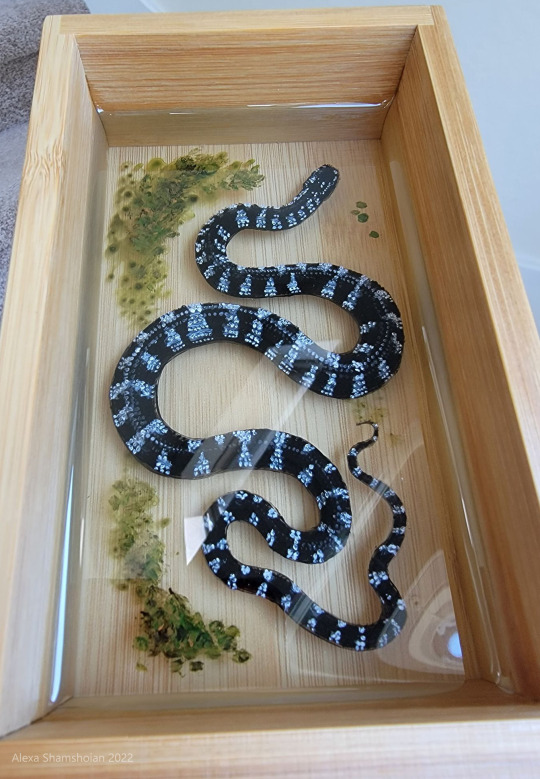
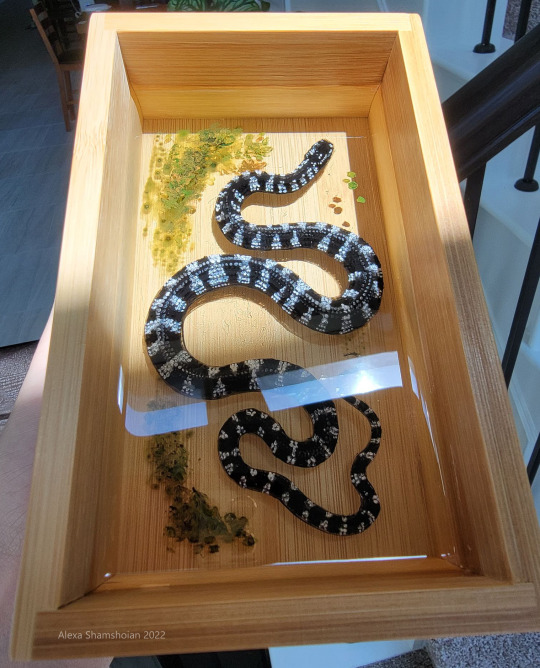

#snake#reptiblr#Acrochordus granulatus#granulated water snake#3D resin painting#resin#artists on tumblr#lexartwork#lexresinworks#my hedge against ai art i guess rip
266 notes
·
View notes
Text
Homalopsis buccata, the masked or puff faced water snake, is an aquatic colubroid species, belonging to an important subclade, called the homalopsids. H. buccata grows to about 100 centimeters or 36 inches in length, and inhabits the low elevation wetlands of Southeast Asia. There is some taxonomic confusion about the genus Homalopsis, but the type species, H. buccata, is native to the Malayan peninsula and western Indonesia. Other species of Homalopsis are known from other regions of Asia, and they all seem to have much the same habitats, behaviors, and care requirements
Snakes have been associated with aquatic environments, ever since the Cretaceous period, from which time a number of marine species are known. Indeed there exists a probable kinship between the snakes and the extinct mosasaurs of that period. Today most of the amphibious to fully aquatic snakes belong to the derived subclade, the colubroids.
Homalopsids are an important clade of aquatic tetrapods in the Old World tropics, extending naturally even into Australasia. Members of this clade vary as to the extent of their salt tolerance. Some homalopsids are physiologically adapted to life in salt water, making them true sea snakes, but others emphatically are not. Homalopsis buccata is a freshwater species.
Homalopsid diets vary according to the species, but their diets are always fish, anurans, or large crustaceans. As a whole, the homalopsids tend not to take prey that is more than 10% of their own size, though at least some species of homalopsid can, and do, take larger items. H. buccata may consume fish that are up to 25% of their own mass, and their diet id primarily fish and frogs. They also consume large crustaceans, although this is scarcely their primary prey preference.
The prey available to snakes is limited by the size of their gape, which is rather extendable in most snakes species. Long items are easier for them to ingest whole, than are bulky items, and those with complex shapes, such as birds, crabs and crayfish, and some fish. Fishes eaten by H. buccata may have complex shapes, such as gouramies, but in these instances they must be small relative to the size of the snake. Whereas attenuated prey can be ingested whole, even if they are large.
Feeding H. buccata is straightforward with defrosted items. They will not in nature consume birds or rodents, so a 'captive snake diet' is scarcely appropriate. Similarly there is no need for live feedings. Homalopsids are opportunistic scavengers, a trait shared with other water snakes, such as natricines, Acrochordus, and water moccasins.
Dead prey is attractive to aquatic snakes, because chemosensory cues travel well in water, and the availability of dead fish in drying pools, provides them with an easy source of food. It has been noted that homalopsids, opon encountering distressed or dead fish, stranded in pools as described, may strike at individuals that are too large for them to eat. They are not good judges of what is suitable prey or not.
Because H. buccata has a high metabolism, it should be fed more often than most captive snakes, for example, three times a week. This species is benign towards animals that are not prey, and people have housed them uneventfully with freshwater turtles, and land animals utilizing different space in the aquaterrarium. They also will cohabit with very large and deep bodied fish, if they are much too big for H. buccata to swallow, or to strike in a misguided predation attempt. One might also caution that many fish, such as snakeheads, are also able to kill snakes.
It is not unknown for H. buccata to bask and the opportunity ought to be made available for them. However they will not use it very much, as they are firmly at the aquatic end of amphibious lifestyles. They are not an estuarine species, any tolerate no more than very lightly brackish salinities, as one of the freshwater faunal elements that predominates at salinities such as 3 5 ppt. No salt ought to be added to their aquarium water, because they are a freshwater species.
The decoration for H. buccata ought to reflect their natural habits of living among root tangles in klongs and ditches. Care should be taken that they will not get trapped in the aquascape, lest they drown. In their natural environments the air temperature is typically 23 to 31 degrees by night, and up to 37 degrees in the day. However what matters for them is that the water temperature is 27 to 33 degrees by day and night. In some environments the water temperature drops by as much as 5 degrees at night, and in others, it does not drop at night by more than a degree.
#Homalopsis buccata#puff-faced water snake#masked water snake#aquatic snakes#aquaterrarium pets#aquatic reptiles
1 note
·
View note
Photo

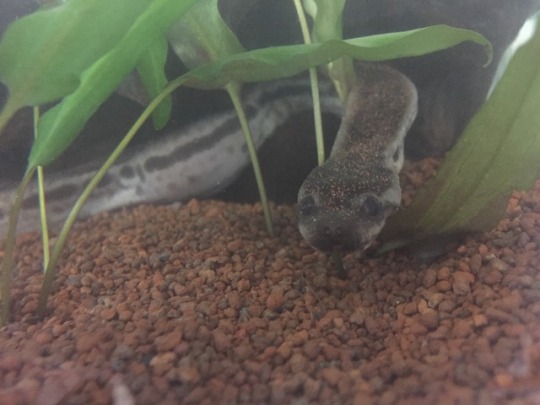
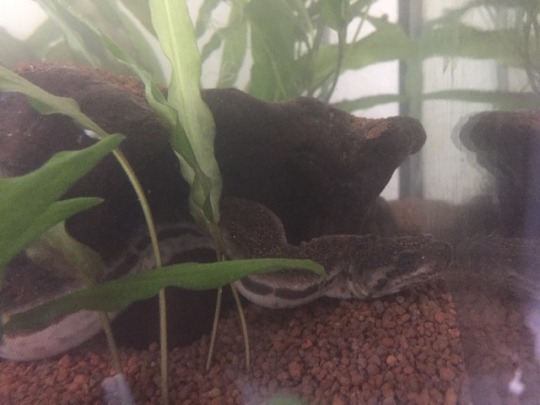

Meet the newest additions to my menagerie! I have acquired two young Acrochordus javanicus, also known as elephant trunk or file snakes. These are fascinating animals, and I am looking forward to working with them.
#snakes#my animals#snake#herpetoculture#Acrochordus#Acrochordus javanicus#they don't have names yet#but I'm working on it#literal wet noodles
589 notes
·
View notes

